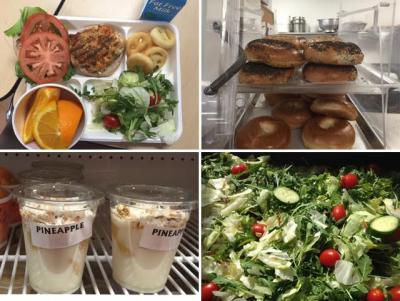Sag Harbor Drops National Lunch Program

While pledging its meals will still be healthy and tasty, the Sag Harbor School District has dropped out of federal programs that reimburse schools for the breakfast foods and lunches they serve when the meals meet rigid nutritional requirements.
The National School Breakfast and Lunch Programs are simply too cumbersome for the district to follow without facing monetary penalties from the government, school administrators said during the Dec. 21 school board meeting.
Jennifer Buscemi, the district’s business administrator, explained during the meeting that the district had been in line with national nutrition standards prior to the passing of the 2013 Healthy Hunger-Free Kids Act, which she said changed things quite a bit — to the point where Pierson Middle and High School’s existing lunch program was no longer in compliance with the new national standards. Nor could it be in the near future, Ms. Buscemi said, without adding significant space, staff, and equipment in the cafeteria.
The main problem, she said, is that the National School Lunch Program’s meal requirements for students in grades 6 through 8 do not overlap with those for students in grades 9 through 12. Each grade grouping has different requirements for calorie content, grain and fruit content, and sodium levels, for example. Pierson’s combined 6th-through-12th grade structure means the school would have to prepare two completely separate lunches each day, one for middle school students and one for high school students. But the school has only one cafeteria and one serving line.
“We have tried to sit down and see if there is a way to do this,” Ms. Buscemi said. “It’s impossible for us to be able to serve two lunches a day for the different age groups.”
The New York State Education Department, which administers the lunch program for the federal government, sent Sag Harbor a letter in October stating its intent to review the district’s food program this year. Ms. Buscemi realized within the last few weeks that the department’s review would likely result in a penalty of more than $53,000, which is the amount Sag Harbor has received in federal reimbursements between September of 2013 and October of 2015, for not complying. The district receives about $18,000 to $19,000 per year from the government for its food program.
Locally, the East Hampton School District participates in the National School Breakfast and Lunch Programs, as does the Bridgehampton School District. Bridgehampton, however, had to pay a penalty of $25,000 two years ago when its production log was found to be not up to par with the program’s requirements. Lois Favre, Bridgehampton’s superintendent, has since said the school is back in compliance.
Other districts across the country have taken similar steps. In 2013, the Associated Press reported schools had begun to drop out of the national food programs when the requirements became too tough to implement. Voorheesville, near Albany, reported losing $30,000 within months of the rollout of the new food standards, according to the Associated Press. However, in a June 2015 follow-up report, the blog BeyondChron.org found that within a year of dropping out of the lunch program, Voorheesville’s losses grew to $90,500 without the federal reimbursements; the district opted back in to the national program in 2014-15.
The federal breakfast and lunch programs also offer some discounts and food donations to participating school districts, but Sag Harbor has received less than $4,000 worth over the past two years. Ms. Buscemi said yesterday that the district also has to rent refrigerated trucks to pick up the donations, so the actual value of the food is much less.
Ms. Buscemi said Sag Harbor could choose to opt back in to the programs at any time, especially if the upcoming capital project, which includes improvements to Pierson’s cafeteria, yields the right circumstances. She also said that since the lunch program became self-sustaining last year for the first time in 10 years, she does not anticipate Sag Harbor needing to subsidize the lunch program with money from its general budget. To make certain that is the case, school officials are considering ways to run the cafeteria with greater efficiency and will most likely raise the price of lunch for teachers and other employees.
Sag Harbor will also continue to participate in the national milk program, and the students who receive free and reduced-price meals will continue to do so. The district will continue to collect applications from eligible families, but will now audit all of the applications that come in, as opposed to auditing only a small percentage, as was dictated by the federal program.
In a letter posted to the district’s website on Tuesday, Ms. Buscemi said the district is committed to providing a “high-quality” breakfast and lunch program that is equivalent to the national program requirements. “The district is most sensitive to the impact of our decision to withdraw from [the programs] and is intent on making the change in such a way that the program provided to our middle and high school students would not present any changes . . . to how our breakfast and lunch programs operate,” she said.
